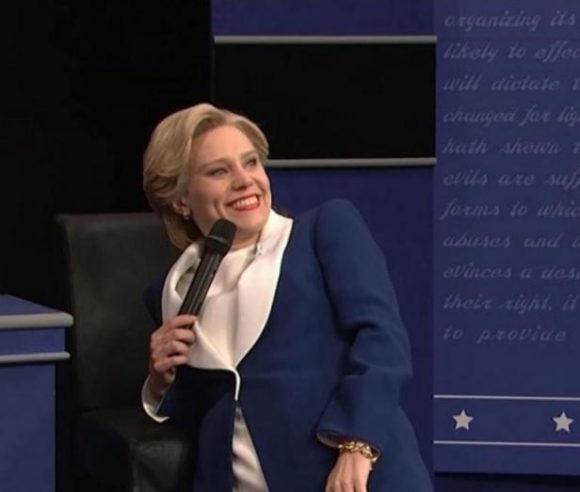At the lunchtime seminar Clinton and Trump: Media Literacy and the U.S. Presidential Elections on September 20, Professor Wendy Hayden (English) discussed her rhetoric course Hillary Clinton and Beyond. This course experimented with a crowdsourced syllabus: Wendy chose the readings only for the first four classes of the semester then turned the syllabus over to the students. Students chose readings in four categories: I. Clinton as Rhetor: texts authored by Clinton, such as the Bejiing speech and June 7th speech; II. Clinton as Subject: texts authored by others about Clinton in the form of speeches (by supporters or opponents), videos, news articles, or opinion articles, such as the Ezra Klein and Rebecca Traister readings; III. Context of Clinton: texts that provide a foundation to discuss the context of Clinton, her historic candidacy, public perception, and rhetoric, such the Declaration of Sentiments, the clip from the documentary Miss Representation, Sarah Palin, and Shirley Chisholm readings; IV. Rhetoricians on Clinton: academic, peer-reviewed articles of rhetorical analysis from a rhetoric or communication journal, such as “Hating Hillary.” In addition to providing two readings and guiding questions for the syllabus, each student completed a post exploring a question about rhetoric in the election; an assignment that reimagined the genre of the literature review where each student was assigned tags from the blog and wrote a post synthesizing the texts on the syllabus with that particular tag; and a final project, which took the forms of digital annotations, rhetorical theory, websites, songs, or teaching resources. All of the students’ work for the semester is public on the Hillary Clinton and Beyond blog. Below is Wendy’s post summarizing the work of the semester.
In the beginning of the semester, we asked what can studying Hillary Clinton at this particular moment teach us about rhetoric? While our work this semester did not always give definitive answers to this or any of our other guiding questions, our inquiry has led to projects that explore these questions further. Some projects explored the role of social media, such as memes and Twitter, in both analyzing and producing the rhetoric that defined and determined the election. Some examined the role of satire as a form of political rhetoric. Some analyzed how humor as rhetoric during the election helped to define an ethos for Clinton.
Ethos became a key theme this semester as the media made trust in Clinton a defining feature of the election. Not all of her ethical appeals were delivered through verbal rhetoric—visual rhetoric also played a large role in Clinton’s ethos. In fact, Clinton’s femininity—or perceived lack of femininity—was often directly tied to a positive or negative perception of Clinton, whether that femininity was connected to dress, speaking voice, or ethical appeals.

We wondered whether the gendered office of president excluded Clinton from making the appeals that would be successful for men and how ethos itself was gendered male.
Questions about ethos and public perception led to several projects that analyzed what journalist Ezra Klein called “the gap”: the gap between perceptions of Clinton from those that know her personally to perceptions of her among the voters. This gap seemed to indicate “two Hillarys“: savior and villain. As yimchristina summarized in her post, “Mind the (Rhetorical) Gap,”
“Clinton’s election loss implies a disconnect between the image she has built for herself as a credible rhetor with variable delivery methods and the distorted image voters received through media coverage.”
Clinton often found herself in a catch 22: if she showed emotion, she risked the “hysterical woman” label; if she did not show emotion, she was accused of being “cold” and “robotic.” Her efforts to appear more “relatable” often led to accusations of inauthenticity.

But, as adelakolenovic theorized, there seemed to be a difference between Clinton the rhetor and Clinton the politician, and, we also saw, Clinton the person, so much so that akreichman asked, “what counts as ‘real’ at this point anyway?” Why do we need to know the “real” Hillary? Why do politicians have to seem relatable?
Some of us felt the answers to these questions was gender. In the same election that we had this historic candidacy, we also saw historic levels of misogyny by her opponent, by the media, and by the voters.
Henry Louis Gates commented in 1996 that hating Hillary seemed to be a national pastime. Hating Hillary was certainly on display this election.
Throughout her long political career, Clinton has had to wear many personas. Her independence and appearance were blamed for Bill Clinton losing a term as governor, so she needed to wear femininity in both appearance and rhetorical style. Karlyn Kohrs Campbell has theorized that much criticism of Clinton as first lady could be explained by her refusal to adorn herself with a feminine style of rhetoric. Female rhetors are expected to present a more maternal persona and avoid the more confrontational rhetoric often employed against them. Clinton’s challenge—appearing feminine while also projecting the confidence and competence needed for the male presidency—led to, in jameswheat’s observation,
a “constant switching back and forth [that] keeps Hillary tied to both feminine and masculine ideals while she remains distanced from them – in this regard, she looks exploitative of both genders and ends up as some agender enigma.”
Clinton was not a perfect candidate. There are many ways she failed her base and many ways in which her feminism lacked intersectionality. allinclusived’s important project showed how Clinton’s rhetoric on race was “inherently divisive.” Her rhetoric often seemed inconsistent.
Though the outcome of the election has provoked much discussion of Clinton’s rhetorical failures, we can ponder how the outcome can be attributed not to Clinton’s failures but to her opponent’s success. We saw gender brought up as a factor in the election more than we did in 2008. We saw a candidate whose strength was listening rather than talking. We saw women’s words define the election’s rhetoric, particularly Michelle Obama’s advice,
“when they go low, we go high.”
This election saw new kinds of rhetoric emerge, from what Rasha Reda theorized as an “anti-ethos” rhetoric to jameswheat’s “PFC Prototype: Perfect Female Candidate Theorized.”
We explored these issues through several genres: digital annotations of speeches, image, two songs, websites, and a timeline. Several projects provide lesson plans, units, assignments, syllabi, and other teaching resources aimed at media literacy. We thought about how we can use these projects as a kind of activism.
As we closed the semester, we found many answers to the question of what studying Clinton at this point in time has taught us about rhetoric:
- The role of rhetoric in shaping public perceptions of politicians
- How fine the line is between what is True and what is “good” rhetoric
- How the way people perceive you can impact the way they view your rhetoric
- What you are saying vs. how you are saying it
- How the wrong kind of rhetoric can lose an election and whether there is a right kind of rhetoric?
- The question of who rhetoric is for
- The question of the power of the rhetor vs the power of the audience
- How the media creates a dramatic narrative
- The impact of gender on delivery
- The patriarchy embedded in the presidency as an institution. Who can be president?
Though there have only been 46 female senators since the country’s founding to 1917 male senators, a female candidate for president did win the popular vote by at least 2.8 million votes.





Comments are closed.